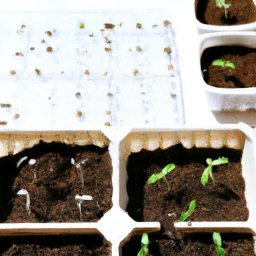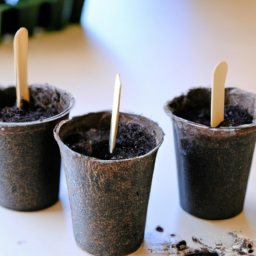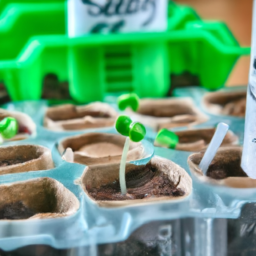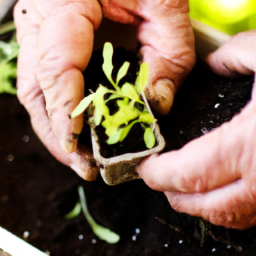
Are you eager to get a head start on your garden this year? One of the best ways to do that is to start seedlings indoors. By starting your seeds indoors, you can give them a jump on the growing season and ensure that they are strong and healthy when it comes time to transplant them outside. In this blog post, we will discuss the benefits of starting seedlings indoors, as well as provide some tips and tricks to help you get started. So grab your gardening gloves and let’s get growing!
Benefits of Starting Seedlings Indoors
Introduction
Starting seedlings indoors can be a rewarding and cost-effective way to kickstart your garden before the growing season begins. By providing a controlled environment for your seedlings to thrive, you can ensure a higher success rate when it comes time to transplant them outside. In this article, we will explore the various benefits of starting seedlings indoors and provide you with a step-by-step guide to get you started.
Increased Success Rate
One of the main benefits of starting seedlings indoors is the increased success rate that comes with it. By starting your seeds in a controlled environment, you can ensure that they have the optimal conditions for germination and growth. This includes providing the right amount of light, water, and nutrients, as well as protecting them from pests and harsh weather conditions. By starting your seedlings indoors, you can give them a head start on the growing season and increase the likelihood of a successful harvest.
In addition, starting seedlings indoors allows you to extend the growing season for certain plants that may not thrive in your climate. By starting seeds indoors and transplanting them outside once the weather warms up, you can grow a wider variety of fruits, vegetables, and flowers than you would be able to if you relied solely on direct seeding outdoors.
Furthermore, starting seedlings indoors can help you save money on buying pre-grown plants from the nursery. By starting your own seedlings, you can choose from a wider variety of plant varieties and save money in the long run by growing your own plants from seed.
Environmental Benefits
Another benefit of starting seedlings indoors is the environmental impact it can have. By growing your own plants from seed, you can reduce the carbon footprint associated with transporting plants from the nursery to your home. Additionally, starting seedlings indoors allows you to control the use of pesticides and fertilizers, which can help reduce the overall environmental impact of your gardening practices.
Furthermore, starting seedlings indoors can help you reduce waste by only growing the plants you need. By starting your own seedlings, you can avoid purchasing excess plants from the nursery that may go to waste if not all of them are planted in your garden. This can help reduce the amount of plant waste that ends up in landfills and contribute to a more sustainable gardening practice.
In conclusion, starting seedlings indoors can have a variety of benefits, including increased success rates, extended growing seasons, cost savings, and environmental benefits. By following the steps outlined in this article, you can start your own seedlings indoors and enjoy a successful and sustainable gardening experience.

Introduction
Starting seedlings indoors is a great way to get a head start on your garden and ensure that your plants have a strong and healthy start. By providing the right conditions and care, you can help your seedlings thrive and grow into healthy plants that will produce a bountiful harvest.
Choosing the Right Containers
When starting seedlings indoors, it’s important to choose the right containers to ensure that your plants have enough room to grow and develop strong roots. Opt for containers that are at least 2-3 inches deep to allow for proper root development. You can use plastic trays, seed starting trays, or even recycled containers such as egg cartons or yogurt cups.
Make sure that the containers have drainage holes to prevent water from pooling at the bottom, which can lead to root rot. Fill the containers with a good quality seed starting mix that is lightweight and well-draining to provide the right environment for your seedlings to grow.
Label your containers with the type of seeds you are planting and the date you started them to keep track of their progress. Place the containers in a warm, sunny location or under grow lights to provide the necessary light for germination and growth.
Providing the Right Conditions
Seedlings need the right conditions to germinate and grow into healthy plants. Keep the soil consistently moist but not waterlogged to prevent damping off, a fungal disease that can kill seedlings. Water from the bottom by placing containers in a tray of water and allowing the soil to soak up the water through the drainage holes.
Provide adequate air circulation by placing a small fan near your seedlings to prevent mold and mildew from forming. Maintain a consistent temperature of around 70-75 degrees Fahrenheit during the day and slightly cooler at night to promote healthy growth.
Fertilize your seedlings with a diluted liquid fertilizer once they have developed their first set of true leaves to provide them with the nutrients they need to thrive. Be careful not to over-fertilize, as this can lead to nutrient burn and damage your seedlings.
Transplanting Seedlings
Once your seedlings have developed several sets of true leaves and have outgrown their containers, it’s time to transplant them into larger pots or into your garden. Gently remove the seedlings from their containers, being careful not to damage the roots, and plant them in a hole that is slightly larger than their root ball.
Water the transplanted seedlings well to help them establish in their new environment. Gradually acclimate them to outdoor conditions by placing them in a sheltered spot for a few hours each day before transplanting them into the garden. This will help prevent transplant shock and ensure that your seedlings continue to thrive.
By following these best practices for starting seedlings indoors, you can ensure that your plants have a strong and healthy start and will be ready to flourish in your garden. With the right care and attention, you can enjoy a bountiful harvest of homegrown fruits, vegetables, and flowers.

Supplies Needed to Start Seedlings Indoors
1. Containers
When starting seedlings indoors, one of the most important supplies you will need is containers to plant your seeds in. There are a variety of options to choose from, including plastic cell packs, peat pots, and seed trays. It is important to choose containers that are clean and have drainage holes to prevent waterlogging. Additionally, make sure the containers are the appropriate size for the type of seedling you are starting.
Plastic cell packs are a popular choice for starting seedlings indoors because they are reusable and easy to clean. Peat pots are biodegradable and can be planted directly into the ground, which can help reduce transplant shock for the seedlings. Seed trays are another option, and they come in a variety of sizes to accommodate different types of seeds.
Regardless of the type of container you choose, make sure to label each one with the type of seed you are planting and the date you planted it. This will help you keep track of your seedlings as they grow and make it easier to identify them once they are ready to be transplanted outdoors.
2. Seed Starting Mix
Another essential supply for starting seedlings indoors is a high-quality seed starting mix. This specialized potting mix is designed to provide the ideal growing conditions for young seedlings, with the right balance of nutrients, moisture retention, and aeration. Avoid using regular garden soil, as it can be too heavy and may contain pests or diseases that could harm your seedlings.
Seed starting mix is typically made from a blend of peat moss, perlite, vermiculite, and other organic materials that promote healthy root development and reduce the risk of damping off disease. It is important to moisten the seed starting mix before planting your seeds, as dry mix can repel water and make it difficult for seeds to germinate.
When choosing a seed starting mix, look for a product that is specifically labeled for starting seeds indoors. This will ensure that it is free of harmful pathogens and has the right texture and structure for seedling growth.
3. Grow Lights
While natural light is ideal for growing seedlings indoors, it may not always be sufficient, especially during the winter months when daylight hours are limited. To ensure that your seedlings receive the light they need to grow strong and healthy, consider investing in grow lights.
There are a variety of grow lights available on the market, including fluorescent, LED, and high-intensity discharge (HID) lights. Fluorescent lights are a popular choice for starting seedlings indoors because they are affordable, energy-efficient, and provide a good spectrum of light for plant growth. LED lights are another option, and they are known for being long-lasting and producing little heat.
When setting up grow lights for your seedlings, position them about 2-4 inches above the tops of the seedlings to provide adequate light intensity. Keep the lights on for 12-16 hours per day to simulate daylight hours and promote healthy growth. Make sure to adjust the height of the lights as the seedlings grow to prevent them from becoming leggy or burned.
Key Takeaways
Starting seedlings indoors is a great way to get a head start on your garden before the weather warms up. By planting seeds indoors, you can control the growing conditions and ensure that your plants have a strong and healthy start. This is especially helpful if you live in a region with a short growing season or unpredictable weather.
To start seedlings indoors, you’ll need containers, soil, seeds, and a warm, sunny spot to place them. Make sure to choose a container that has drainage holes to prevent overwatering. Fill the container with a seed-starting mix, plant your seeds according to the instructions on the packet, and place them in a warm location with plenty of sunlight. Keep the soil moist but not waterlogged, and watch as your seedlings begin to sprout and grow. Once they have developed a few sets of leaves, they can be transplanted into larger pots or directly into the garden. Starting seedlings indoors is a fun and rewarding way to kick off the gardening season and ensure a bountiful harvest later on.
Q&A Corner:
Q1: What are the benefits of starting seedlings indoors?
A1: Starting seedlings indoors allows you to control the growing conditions, such as temperature and light, which can help ensure successful germination and early growth. It also extends the growing season, giving your plants a head start before transplanting them outdoors.
Q2: What supplies do I need to start seedlings indoors?
A2: To start seedlings indoors, you will need containers for planting, seed starting mix, seeds, a light source (such as a grow light), and a consistent source of warmth. You may also need trays for water drainage and a spray bottle for watering.
Q3: When is the best time to start seedlings indoors?
A3: The best time to start seedlings indoors will depend on the specific plants you are growing and your local climate. As a general rule, start seedlings indoors 4-6 weeks before your last frost date to give them enough time to grow before transplanting them outdoors.
Q4: How often should I water my seedlings indoors?
A4: It’s important to keep the soil moist but not waterlogged when growing seedlings indoors. Check the soil regularly and water when it feels dry to the touch. Avoid overwatering, as this can lead to root rot.
Q5: How can I help my seedlings grow strong and healthy indoors?
A5: To help your seedlings grow strong and healthy indoors, make sure they are getting enough light, water, and nutrients. Rotate the containers regularly to promote even growth, and consider using a fan to simulate outdoor breezes, which can help strengthen the plants’ stems.
Dr. Olivia Green is a botanist with over two decades of experience in indoor plant cultivation. She holds a Ph.D. in Plant Biology and has dedicated her career to researching plant behavior in controlled environments. Dr. Green is passionate about helping plant enthusiasts master the art of indoor gardening through her extensive knowledge and practical insights.


